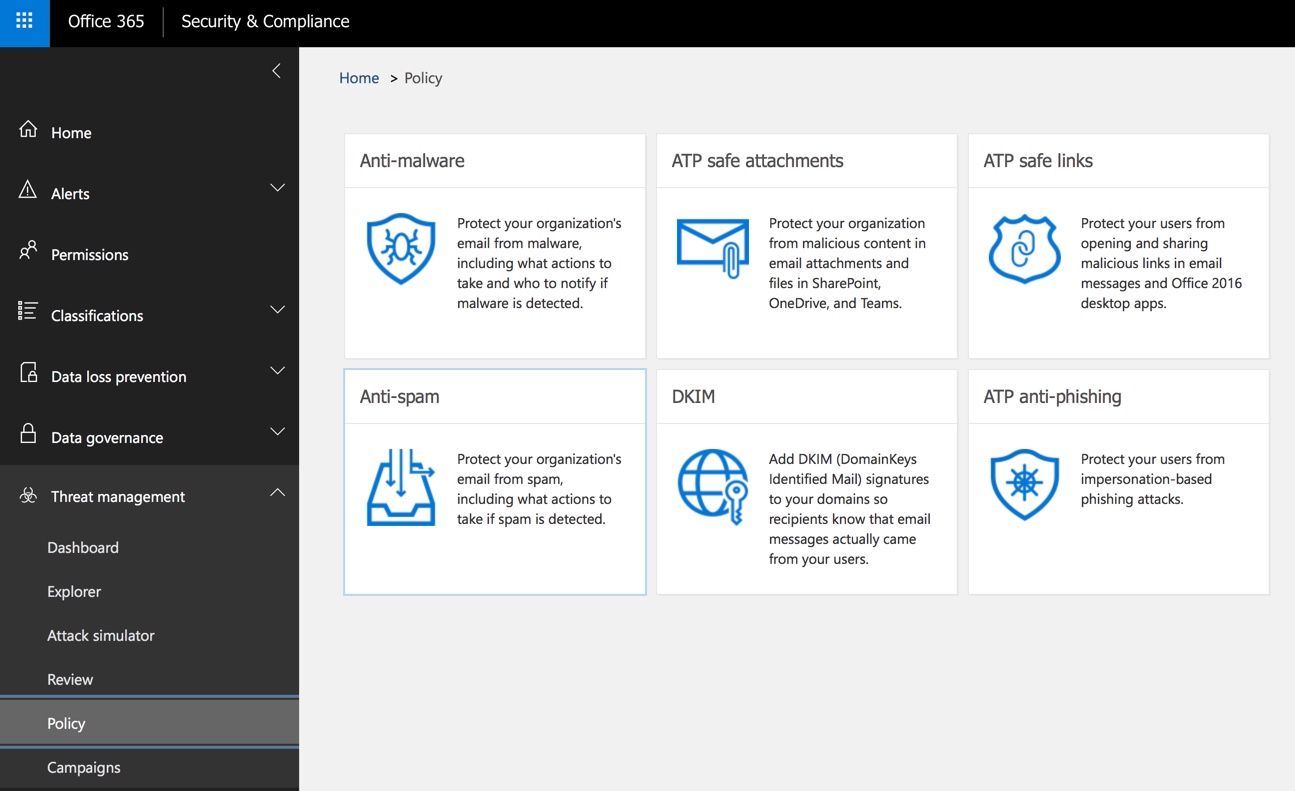- (888) 764-0688
- [email protected]
- 24-hour Phone Support

Advanced Threat Protection (ATP) is a crucial component of any modern and comprehensive network security infrastructure. The cyber threat landscape and attack surface areas are increasing in size for businesses around the world. Cybercriminals are using existing and new techniques to probe and penetrate the networks, systems, and applications in organizations of all sizes. Staying informed about emerging threats and attack vectors is a full-time pursuit. Many organizations can’t dedicate the resources required to keep current in this area, or they may find that the demand for skilled cybersecurity professionals makes it hard to recruit the necessary IT staff. Staying fully up to date on all emerging threats also means that experienced IT security professionals have significantly less time to spend on other projects that drive the organization forward.
We are continuing to add new features to Office 365 ATP. To learn more about new features coming to ATP (or Microsoft 365 in general), see the following resources:
ATP can be used with any SMTP mail transfer agent, such as Microsoft Exchange Server. For information about the operating systems, web browsers, and languages that are supported by ATP, see the “Supported browsers” and “Supported languages” sections in Exchange admin center in Exchange Online Protection.

ATP Safe Attachments protects against unknown malware and viruses, and provides zero-day protection to safeguard your messaging system. All messages and attachments that don’t have a known virus/malware signature are routed to a special environment where ATP uses a variety of machine learning and analysis techniques to detect malicious intent. If no suspicious activity is detected, the message is released for delivery to the mailbox.
ATP Safe Attachments scanning takes place in the same region where your Office 365 data resides. For more information about data center geography, see Where is your data located?
The ATP Safe Links feature proactively protects your users from malicious URLs in a message or in an Office document. The protection remains every time they select the link, as malicious links are dynamically blocked while good links can be accessed.
Safe Links is available for URLs in the following apps:
Users must be licensed for ATP*, must be included in ATP Safe Links policies, and must be signed in on their devices for protection to be in place.
* For organization-wide ATP licenses (for example, ATP_ENTERPRISE_FACULTY), you don’t need to assign ATP licenses to individual users.
For more information about ATP Safe Links protection, see How ATP Safe Links works with URLs in Office documents.
ATP for SharePoint, OneDrive, and Microsoft Teams helps detect and block files that are identified as malicious in team sites and document libraries. In addition, ATP Safe Links protection is now available in Microsoft Teams channels and chats.
ATP anti-phishing checks incoming messages for indicators that a message might be a phishing attempt. When users are covered by ATP policies (Safe Attachments, Safe Links, or anti-phishing), incoming messages are evaluated by multiple machine learning models that analyze messages and the appropriate action is taken, based on the configured policies.
Monitoring capabilities available in the Security & Compliance Center include real-time reports and insights that let your security and compliance administrators focus on high-priority issues, such as security attacks or increased suspicious activity. In addition to highlighting problem areas, smart reports and insights include recommendations and links to view and explore data and also take quick actions.
Explorer (also referred to as Threat Explorer) is a real-time report that lets authorized users identify and analyze recent threats. By default, this report shows data for the past 7 days; however, views can be modified to show data for the past 30 days.
Explorer contains views, such as Malware (for email and content), Submissions, Phish, and All Email. To see how Explorer compares with real-time detections, download this PDF.
For more information about Explorer (in Office 365 Advanced Threat Protection Plan 2) and real-time detections (in Office 365 Advanced Threat Protection Plan 1), see Threat Explorer and real-time detections.
Real-time detections is a real-time report that lets authorized users identify and analyze recent threats. Similar to Explorer, by default, this report shows data for the past 7 days.
Real-time detections contain views, such as Malware (for email and content), Submissions, and Phish. To see how real-time detections compare with Explorer, download this PDF.
For more information about Explorer (in Office 365 Advanced Threat Protection Plan 2) and real-time detections (in Office 365 Advanced Threat Protection Plan 1), see Threat Explorer (and real-time detections).
Threat Trackers are informative widgets and views that provide authorized users with intelligence on cybersecurity issues that might impact your organization.
Automated incident response (AIR) capabilities available in Office 365 ATP Plan 2 enable you to run automated investigation processes in response to well known threats that exist today. By automated certain investigation tasks, your security operations team can operate more efficiently and effectively. Remediation actions, such as deleting malicious email messages, are taken upon approval by your security operations team. To learn more, see How AIR works in Office 365.
Attack Simulator lets authorized users run realistic attack scenarios in your organization. Several different kinds of attacks are available, including a display name spear-phishing attack, a password-spray attack, and a brute-force password attack.

| Cookie | Duration | Description |
|---|---|---|
| cookielawinfo-checkbox-analytics | 11 months | This cookie is set by GDPR Cookie Consent plugin. The cookie is used to store the user consent for the cookies in the category "Analytics". |
| cookielawinfo-checkbox-functional | 11 months | The cookie is set by GDPR cookie consent to record the user consent for the cookies in the category "Functional". |
| cookielawinfo-checkbox-necessary | 11 months | This cookie is set by GDPR Cookie Consent plugin. The cookies is used to store the user consent for the cookies in the category "Necessary". |
| cookielawinfo-checkbox-others | 11 months | This cookie is set by GDPR Cookie Consent plugin. The cookie is used to store the user consent for the cookies in the category "Other. |
| cookielawinfo-checkbox-performance | 11 months | This cookie is set by GDPR Cookie Consent plugin. The cookie is used to store the user consent for the cookies in the category "Performance". |
| viewed_cookie_policy | 11 months | The cookie is set by the GDPR Cookie Consent plugin and is used to store whether or not user has consented to the use of cookies. It does not store any personal data. |